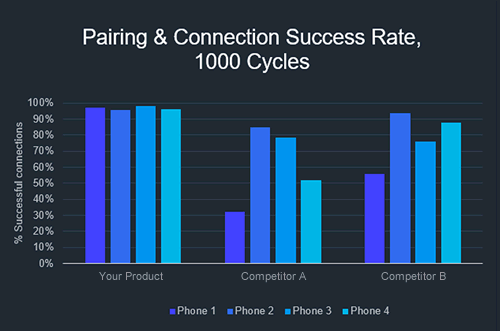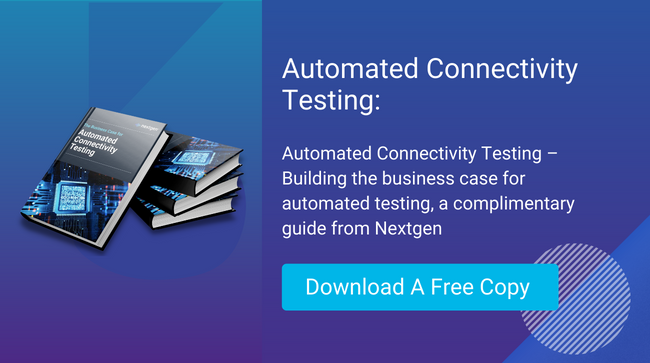Making The Right Connections: Understanding Bluetooth and Wi-Fi Testing

In our increasingly interconnected world, Bluetooth and Wi-Fi have emerged as major drivers of innovation in product connectivity, enabling developments in fields such as consumer electronics and industrial IoT. They are cornerstones in the rise of smart homes, business technology, and automation processes.
With Bluetooth device shipments to reach 6.5 billion devices and the number of Wi-Fi IoT devices expected to grow at a CAGR of around 24% by 2025, the creation of new products and use cases is increasing at an unprecedented rate, it's crucial to get the basics of Bluetooth and Wi-Fi interoperability testing right from the start.
The Testing Challenge
As anyone managing connected product testing will tell you, it's far from straightforward to get a product ready for market. It's a fine balancing act that requires the coordination of different elements of the business under strict deadlines and with significant reputational implications.
The complexity and growing use cases for products necessitate a shift towards automated testing. However, automated testing doesn't diminish the need for an in-depth understanding of potential issues and end-user experiences. Instead, it enhances it.
A Structured Approach
To overcome these challenges, these are the six foundations for creating a robust and successful Bluetooth & Wi-Fi testing strategy:
1. Embrace Automation:
Product Interoperability testing is a great example of how automation can help tackle complex scenarios that manual testing of connected products can't. It enhances the possibilities of testing in environments like warehouses where Bluetooth Mesh is employed, or in situations demanding expansive test coverage like in Bluetooth LE broadcasting.
2. Build a Device Library:
Your tests are only as good as the devices you use. Establishing a library of devices with which your product will likely interact in the real world is vital. This involves considering factors like device age, regional differences, and specific in-market products and user interface diversity across world regions.
3. Invest in Quality Tools:
Using leading analysis tools and automation platforms can maintain competitive advantage, save time, effort, and stress. Up-to-date knowledge and training are equally important for your engineers to effectively interpret and analyse data sets.
4. Ongoing Testing:
Testing isn't a one-off process. To ensure user satisfaction, continuous testing is needed, both during development and post-launch, to accommodate new product releases.
5. Transparency in Results:
Building trust with your customers means being open about your testing results. This transparency helps users understand and resolve issues they might encounter, whether or not your device is at fault.
6. Leverage Testing Events:
Events like Bluetooth UnPlugFests and Wi-Fi Alliance member meetings offer valuable insights into your product’s connectivity performance and keep you updated on these technologies and also future third-party product releases.
 Image showing 1000 Cycles Automated Test Connection Results
Image showing 1000 Cycles Automated Test Connection Results
Potential Performance and Interoperability Issues
To effectively test your products for market readiness, you should be aware of common performance and interoperability issues that persist despite the advancements in Bluetooth and Wi-Fi technologies:
1. Variable Device Range
Bluetooth connections do not have a consistent operable range. Environmental factors and the presence of obstructions can impact signal strength. Wi-Fi bands have variable characteristics and transmission speeds reduce with range.
2. Inconsistent Profile Support:
Even though devices may be certified, differences in Bluetooth stack support can lead to interoperability issues. Backward compatibility between different Wi-Fi standards and bands can lead to unexpected connectivity and performance issues.
3. Connection Issues:
Flawless initial pairing and connection are key for any Bluetooth connection process. Wi-Fi client devices may fail to associate with Access Points due to compatibility issue that were unknown at the time of device launch. Devices may disconnect and fail to reconnect, impacting user experience and causing frustration.
4. Wi-Fi Throughput:
Wi-Fi data transmission speeds can affect user experiences, particularly in cases of on-demand video streaming or long-term connection stability. Transmission speed characteristics are affected by Wi-Fi band, channel assignments, congestion and external interference from other Wi-Fi and wireless signals.
5. Compliance Standards:
Multiple iterations of Bluetooth and Wi-Fi standards have been rolled out over the last two decades, creating potential incompatibility and interoperability issues between older and newer devices.
6. Data Transfer Speed:
As the distance between devices increases, data transfer rates can drop. However, if reliable connection is more important, for example smart home devices and the data rate is adequate for user requirements, this may not pose an issue, each use case is different.
7. Audio Quality:
Factors like distance, interference, and coexistence can impact audio quality, variable rate codecs have different audio characteristics potentially causing latency or interruption of audio streams and difference in audio quality. Issues with voice quality and music quality can be encountered in systems where multi-channel audio streams provide key functionality such as Bluetooth LE Audio and Auracast or multi-room Wi-Fi audio systems.
8. Frequency Band Discrepancies:
Wi-Fi channels and placements of these channels vary regionally, and different countries may have rules for external signals like RADAR and other infrastructure traffic which must be prioritised over Wi-Fi which can impact performance and interoperability. Both 2.4GHz Wi-Fi and Bluetooth operate in the same frequency range, thus testing co-existence performance for both standards is crucial. The simultaneous operation of multi-band radios on multiple frequency bands in 5Ghz and 6GHz Wi-Fi and Mesh systems means that 2.4GHz co-existence testing is also a key component of Wi-Fi interoperability test plans.
In Summary
As Carl Sagan said, “We've arranged a civilization in which most crucial elements profoundly depend on science and technology.” As fundamental technologies that connect our world, the ongoing success of Bluetooth and Wi-Fi relies on rigorous, intelligent testing backed by a thoughtfully crafted strategy.
When used correctly, automation, investing in tools and resources, continuous testing, transparency, and learning opportunities can streamline the process of bringing a product to market. At the same time, understanding potential interoperability issues provides a roadmap for effective testing and troubleshooting.
The result is not only better products and user experiences but also the opportunity for your business to maintain a competitive edge in the rapidly evolving landscape of connected technology. In turn, this creates reputational benefits and sets your company up for long-term success.
Next Steps
Integrating automated testing into your development cycle significantly enhances Wi-Fi and Bluetooth product testing, allowing early detection and resolution of potential issues. Tools like Nextgen ATAM Connect efficiently validate multiple product aspects, including regression testing and interoperability testing compatibility with various wireless standards. This approach not only saves time and effort from manual testing but also bolsters the accuracy and reliability of test outcomes.
Furthermore, platforms like as Nextgen ATAM Connect keep performance top-notch, as automation empowers developers to swiftly adapt to the latest revisions and updates. Through incorporating automated testing in the development journey, product developers can guarantee their products provide a smooth and intuitive user experience.
For more information about Nextgen ATAM Connect or our testing services and how Nextgen can support your product development, please contact us today or call +44 3331 120 000.




